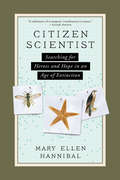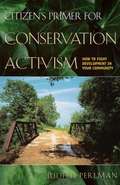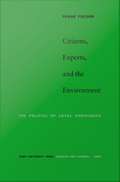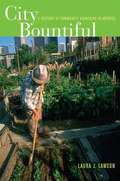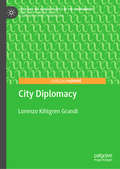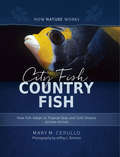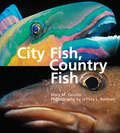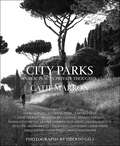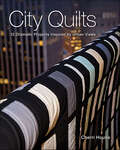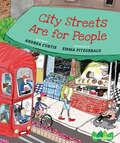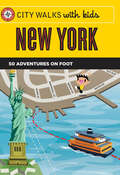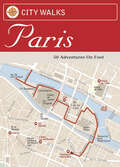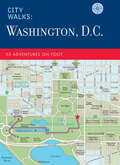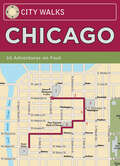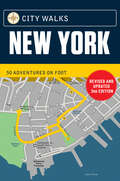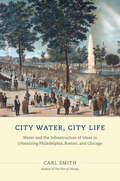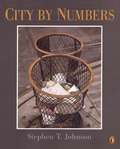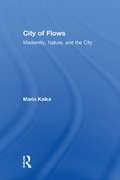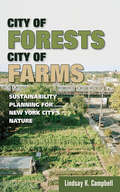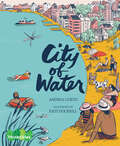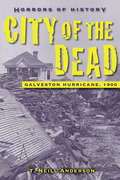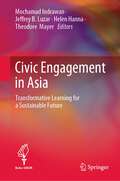- Table View
- List View
Citizen Scientist: Searching for Heroes and Hope in an Age of Extinction
by Mary Ellen HannibalA San Francisco Chronicle Best Book of the Year: “Intelligent and impassioned, Citizen Scientist is essential reading for anyone interested in the natural world.”A Nautilus Award Winner in Ecology and EnvironmentAward-winning writer Mary Ellen Hannibal has long reported on scientists’ efforts to protect vanishing species. But it was only through citizen science that she found she could take action herself. As she wades into tide pools, spots hawks, and scours mountains, she discovers the power of the heroic volunteers who are helping scientists measure—and even slow—today’s unprecedented mass extinction. Citizen science may be the future of large-scale field research—and “might be our last, best hope for solving myriad environmental predicaments” (Library Journal).our planet’s last, best hope.“Inspired by the likes of marine biologist Ed Ricketts, [Hannibal] records starfish die-offs, meets the geeks who track deforestation, and plans a web-based supercommunity of citizen scientists to counter what many are calling the sixth great extinction. A cogent call to action.” —Nature“Hannibal’s use of details verges on the sublime.” —East Hampton Star“[A] celebration of nonexperts’ contributions to science.” —Scientific American
Citizen's Primer for Conservation Activism: How to Fight Development in Your Community
by Judith PerlmanIs there anything you can do when development threatens your local forest, beach, prairie, or wetland? Yes, there is. Across America, citizen activists are fighting and winning battles against unwanted development in their own communities. To help you resist the urban sprawl and absentee landowners that can wreck small towns and cities alike, this book is a practical, hands-on guide for building a grassroots campaign to defeat undesirable development. Written by a successful activist, Citizen's Primer for Conservation Activism takes you through all the steps necessary to stop unplanned development in your community:- Identifying the issues at stake- Getting involved and developing leadership- Devising a strategy- Hiring and working with legal counsel- Building coalitions and partnerships- Influencing local government- Conducting a media campaign- Raising money- Countering developer tactics- Managing the whole processWith the proven strategies in this easy-to-access book, you can quickly gear up to challenge unwanted development and preserve the character of your local community.
Citizens, Experts, and the Environment: The Politics of Local Knowledge
by Frank FischerThe tension between professional expertise and democratic governance has become increasingly significant in Western politics. Environmental politics in particular is a hotbed for citizens who actively challenge the imposition of expert theories that ignore forms of local knowledge that can help to relate technical facts to social values. Where information ideologues see the modern increase in information as capable of making everyone smarter, others see the emergence of a society divided between those with and those without knowledge. Suggesting realistic strategies to bridge this divide, Fischer calls for meaningful nonexpert involvement in policymaking and shows how the deliberations of ordinary citizens can help solve complex social and environmental problems by contributing local contextual knowledge to the professionals' expertise. While incorporating theoretical critiques of positivism and methodology, he also offers hard evidence to demonstrate that the ordinary citizen is capable of a great deal more participation than is generally recognized. Popular epidemiology in the United States, the Danish consensus conference, and participatory resource mapping in India serve as examples of the type of inquiry he proposes, showing how the local knowledge of citizens is invaluable to policy formation. In his conclusion Fischer examines the implications of the approach for participatory democracy and the democratization of contemporary deliberative structures. This study will interest political scientists, public policy practitioners, sociologists, scientists, environmentalists, political activists, urban planners, and public administrators along with those interested in understanding the relationship between democracy and science in a modern technological society.
Citizenship in the World (Merit Badge Series)
by Boy Scouts of AmericaThis merit badge booklet introduces scouts to their place as citizens of the world as a whole.
City Bountiful: A Century of Community Gardening in America
by Laura J. LawsonSince the 1890s, providing places for people to garden has been an inventive strategy to improve American urban conditions. There have been vacant-lot gardens, school gardens, Depression-era relief gardens, victory gardens, and community gardens―each representing a consistent impulse to return to gardening during times of social and economic change. In this critical history of community gardening in America, the most comprehensive review of the greening of urban communities to date, Laura J. Lawson documents the evolution of urban garden programs in the United States. Her vibrant narrative focuses on the values associated with gardening, the ebb and flow of campaigns during times of social and economic crisis, organizational strategies of these primarily volunteer campaigns, and the sustainability of current programs.
City Diplomacy (Cities and the Global Politics of the Environment)
by Lorenzo Kihlgren GrandiThis book presents an accessible overview of the seven key concepts of city diplomacy (development cooperation, peacekeeping, economy, innovation, environment, culture, and migration). The book discusses its scope and challenges, maps the actors involved along with their interaction and offers suggestions for available tools and outcomes. Each chapter includes an analysis of a selection of best practices. The book successfully combines theory with practical evidence and will be an invaluable reference for students and researchers of international relations and urban studies looking for a comprehensive and updated analysis of the multifaceted international action of cities. The book will also be of interest to practitioners and city officials responsible for the design and implementation of impactful diplomatic strategies.
City Fish Country Fish: How Fish Adapt To Tropical Seas And Cold Oceans (How Nature Works #0)
by Mary M. Cerullo Jeffrey L. Rotman* School Library Journal Starred Review * * Honor Book SSLI (Society of School Librarians International) * *Skipping Stones Honor Book* Fish that live in tropical seas are like city dwellers, packed into reefs and surrounded by life in great variety and urgent motion,Fish that live in tropical seas are like city dwellers, packed into reefs andsurrounded by life in great variety and urgent motion, day and night. Through color, shape,size, and other adaptations, city fish and country fish have evolved to survive in their particular habitats.In City Fish, Country Fish, Mary Cerullo uses this powerful analogy and Jeffrey Rotman’s vibrant underwater photos to captivate young readers with the wild variety of ocean life. The second edition of this popular book includes new information about the effects of climate change on fish and their habitats and about great white sharks, who are among the few species who roam back and forth between cold and tropical waters. Fountas & Pinnell Level T
City Fish, Country Fish
by Mary M. Cerullo Jeffry RotmanSome people live in the country, close to the land, where they enjoy peace and quiet. Others live in high-rise apartments in the city and love the hustle and bustle of crowds and nonstop activity, both day and night. In the ocean, too, there are places that have some of the characteristics of the country or of the city. Like the classic tale of The City Mouse and the Country Mouse, there are advantages and disadvantages to each habitat. We'll compare how the fishes that live in tropical seas (the city) and those that swim through cold oceans (the country) meet the challenges and opportunities of their own ecosystems. We will examine how color, shape, and size, as well as behaviors and adaptations, help them survive in their particular habitat. We'll explore characteristics that make them different, as well as things that make them the same.
City Parks: Public Spaces, Private Thoughts
by Catie MarronCatie Marron’s City Parks captures the spirit and beauty of eighteen of the world’s most-loved city parks. Zadie Smith, Ian Frazier, Candice Bergen, Colm Tóibín, Nicole Krauss, Jan Morris, and a dozen other remarkable contributors reflect on a particular park that holds special meaning for them.Andrew Sean Greer eloquently paints a portrait of first love in the Presidio; André Aciman muses on time’s fleeting nature and the changing face of New York viewed from the High Line; Pico Iyer explores hidden places and privacy in Kyoto; Jonathan Alter takes readers from the 1968 race riots to Obama’s 2008 victory speech in Chicago’s Grant Park; Simon Winchester invites us along on his adventures in the Maidan; and Bill Clinton writes of his affection for Dumbarton Oaks.Oberto Gili’s color and black-and-white photographs unify the writers’ unique and personal voices. Taken around the world over the course of a year, in every season, his pictures capture the inherent mood of each place. Fusing images and text, City Parks is an extraordinary and unique project: through personal reflection and intimate detail it taps into collective memory and our sense of time’s passage.
City Quilts: 12 Dramatic Projects Inspired By Urban Views
by Cherri HouseDiscover Endless Design Possibilities in Everything from Parks to Parking Lots! • Create city-inspired quilts by piecing together simple geometric shapes • Beginner-friendly project designs are inspired by modern urban architecture and landscapes • Learn how to achieve dramatic looks with more effective use of color, value, and placement • Work with traditional blocks like Flying Geese and Log Cabin in a new way Turn your love of urban cityscapes into beautiful quilts. In this book, you'll discover the secrets of minimalist design-how to find beauty in the basic elements of your environment. These projects deliver exciting, vivid results with solid color fabrics. City Quilts was named one of the Best Books of 2010 in the Fiber Crafts Category by Library Journal, and is a finalist in the 2010 Foreword Book of the Year Awards.
City Streets Are for People (ThinkCities #3)
by Andrea CurtisCongested city streets are noisy and thick with cars and trucks, while pedestrians and cyclists are squeezed to the dangerous edges—but does it have to be this way? Imagine a city where we aren’t stuck in cars, where clean air makes it easier to breathe, and where transit is easy to access—and on time. Imagine a city where streets are for people! This fun, accessible and ultimately hopeful book explores sustainable transportation around the globe, including electric vehicles, public transit, bicycles, walking and more. It invites us to conjure up a city of the future, where these modes are all used together to create a place that is sustainable, healthy, accessible and safe. Includes a list of ideas for children to promote green transportation in their communities, along with a glossary and sources for further reading. The ThinkCities series is inspired by the urgency for new approaches to city life as a result of climate change, population growth and increased density. It highlights the challenges and risks cities face, but also offers hope for building resilience, sustainability and quality of life as young people advocate for themselves and their communities. Key Text Features diagrams facts further information further reading glossary historical context illustrations labels resources references Correlates to the Common Core State Standards in English Language Arts: CCSS.ELA-LITERACY.RI.4.7 Interpret information presented visually, orally, or quantitatively (e.g., in charts, graphs, diagrams, time lines, animations, or interactive elements on Web pages) and explain how the information contributes to an understanding of the text in which it appears. CCSS.ELA-LITERACY.RI.5.3 Explain the relationships or interactions between two or more individuals, events, ideas, or concepts in a historical, scientific, or technical text based on specific information in the text. CCSS.ELA-LITERACY.RI.6.6 Determine an author's point of view or purpose in a text and explain how it is conveyed in the text.
City Walks Architecture: New York (City Walks)
by Alissa Walker John SpellmanPacked with 25 walking adventures, this unique guide uncovers the Big Apple's most breathtaking buildings, parks, and monuments! Each page focuses on a specific area and features helpful background information, detailed walking instructions, a full-color map, and stunning photography. Covering both landmark structures and little-known wonders, this is the perfect gift for design-savvy travelers and adventurous locals alike.Walks include:Greenwich VillageEmpire State BuildingCentral ParkWorld Trade Center SiteAnd more!
City Walks with Kids: 50 Adventures on Foot (City Walks)
by Elissa SteinTake a walk to NYC destinations both parents and kids can enjoy—includes fifty family-friendly tours.From the Staten Island Children’s Museum to the Roosevelt Island Tram to the New York City Police Museum, New York City is full of family-friendly places to go. Don’t worry about finding a sitter—these adventures are designed especially for grownups and kids to discover the Big Apple together!Walks include: Central Park * Children’s Museum of the Arts * Coney Island * Chinatown * South Street Seaport * The Strand and the Forbidden Planet * Hudson River * New York City Fire Museum * Sony Wonder Technology Lab * and much more
City Walks: 50 Adventures on Foot (City Walks)
by Christina Henry de Tessan Reineck And ReineckParis is a perfect city to explore à pied, and this ebook is designed for just that. On each page you'll find an illustrated map and, on the flip side, insider info on where to eat, drink, stop, and shop. With these 50 self-guided walking adventures you can explore historic sites, from the Arc de Triomphe to the Musée du Louvre, as well as uncover lesser-known gems, from open-air markets and intimate cafes to small museums with world-class art. Choose any page, and Paris is yours for the taking.
City Walks: 50 Adventures on Foot (City Walks)
by Christina Henry de TessanSkip the tour bus and experience the nation’s capital on foot with this guide to walkable Washington! City Walks: Washington, D.C. provides an insider’s view of the United States’ capital city, from historical landmarks to hot spots. Each page in this ebook outlines a self-guided walking adventure, complete with detailed map and local secrets. Pick any page and start exploring—and discover the best places to eat, drink, stop, shop, rest, walk, and play.
City Walks: 50 Adventures on Foot (City Walks)
by Christina Henry de TessanStroll the Magnificent Mile and more with fifty Chicago walking tours.Explore Chicago like a native with this convenient ebook offering maps and information to guide you through numerous enjoyable and enlightening walks that highlight both the history of this Midwestern city and the shopping, dining, and nightlife it offers.Discover landmarks like Millennium Park, the Loop, the Magnificent Mile, and Navy Pier—along with the many lesser-known local delights along the way!
City Walks: 50 Adventures on Foot (City Walks)
by Henry de TessanThe revised and updated third edition of the classic walking guide to San Francisco.This list of walking tours in San Francisco features brand new neighborhoods, restaurants, shops, and landmarks. Perfect for tourists exploring in the Bay Area, recent transplants, or even locals who want to become familiar with a new part of the city, this ebook shares the hidden gems of San Francisco. Each walk, from The Presidio to Japantown to the Embarcadero and the Exploratorium, is detailed with a full-color map, walking directions, and highlighted stopping points.
City Walks: 50 Adventures on Foot (City Walks)
by Henry de TessanThis city was made for walking—navigate the sidewalks of New York with this updated guide.Featuring brand-new walks, neighborhoods, restaurants, shops, and more, this revised guide reveals New York’s best-kept secrets as well as its best-known landmarks, from the Brooklyn Bridge to the High Line to the new Freedom Tower. Each of the fifty tours includes a full-color map, walking directions, and highlighted stopping points. It’s ideal for anyone who wants to make the most of NYC—be it transplant, traveler, or native.
City Water, City Life: Water and the Infrastructure of Ideas in Urbanizing Philadelphia, Boston, and Chicago
by Carl SmithA city is more than a massing of citizens, a layout of buildings and streets, or an arrangement of political, economic, and social institutions. It is also an infrastructure of ideas that are a support for the beliefs, values, and aspirations of the people who created the city. In "City Water, City Life," celebrated historian Carl Smith explores this concept through an insightful examination of the development of the first successful waterworks systems in Philadelphia, Boston, and Chicago between the 1790s and the 1860s. By examining the place of water in the nineteenth-century consciousness, Smith illuminates how city dwellers perceived themselves during the great age of American urbanization. aBut "City Water, City Life" is more than a history of urbanization. aIt is also a refreshing meditation on water as a necessity, as a resource for commerce and industry, and as an essentialOCoand centralOCopart of how we define our civilization.
City by Numbers
by Stephen T. JohnsonIn the ideal follow-up to his stunning Caldecott Honor book <i>Alphabet City</i>, Stephen T. Johnson turns his talents towards numbers. Wordless spreads featuring impressively photo-realistic paintings of New York City invite readers both young and old to search for the numbers zero through twenty-one hidden in the images. From a sweeping 4 found in the span of an urban bridge to the 13 of a faded crosswalk, this is an intriguing new way to think about numbers and the world around you.
City of Flows: Modernity, Nature, and the City
by Maria KaikaTypically, cities and nature are perceived as geographic opposites, cities being manufactured social creations, and nature being outside of human construction. Through a historical geography of water in the modern city, Kaika shows that this is not the case. Rather, nature and the modern city are fully intertwined, with cities integrating nature at
City of Forests, City of Farms: Sustainability Planning for New York City’s Nature
by Lindsay K. CampbellCity of Forests, City of Farms is a history of recent urban forestry and agriculture policy and programs in New York City. Centered on the 2007 initiative PlaNYC, this account tracks the development of policies that increased sustainability efforts in the city and dedicated more than $400 million dollars to trees via the MillionTreesNYC campaign. Lindsay K. Campbell uses PlaNYC to consider how and why nature is constructed in New York City. Campbell regards sustainability planning as a process that unfolds through the strategic interplay of actors, the deployment of different narrative frames, and the mobilizing and manipulation of the physical environment, which affects nonhuman animals and plants as well as the city's residents.Campbell zeroes in on a core omission in PlaNYC's original conception and funding: Despite NYC having a long tradition of community gardening, particularly since the fiscal crisis of the 1970s, the plan contained no mention of community gardens or urban farms. Campbell charts the change of course that resulted from burgeoning public interest in urban agriculture and local food systems. She shows how civic groups and elected officials crafted a series of visions and plans for local food systems that informed the 2011 update to PlaNYC. City of Forests, City of Farms is a valuable tool that allows us to understand and disentangle the political decisions, popular narratives, and physical practices that shape city greening in New York City and elsewhere.
City of Water (ThinkCities)
by Andrea CurtisThe second book in the ThinkCities series explores water as a precious, finite resource, tracing its journey from source, through the city, and back again. Living in cities where water flows effortlessly from our taps and fountains, it’s easy to take it for granted. City of Water, the second book in the ThinkCities series, shines a light on the water system that is vital for our health and well-being. The narrative traces the journey of water from the forests, mountains, lakes, rivers and wetlands that form the watershed, through pipes and treatment facilities, into our taps, fire hydrants and toilets, then out through storm and sewer systems toward wastewater treatment plants and back into the watershed. Along the way we discover that some of the earliest cities with water systems date back to the Indus Valley in 2500 BC; that in 1920 only 1 percent of the US population had indoor plumbing; that if groundwater is used up too quickly, the land can actually sink; and more. The text is sprinkled with fun and surprising facts — some water fountains in Paris offer sparkling water, and scientists are working to extract microscopic particles of precious metals found in sewage. Readers are encouraged to think about water as a finite resource, and to take action to prevent our cities and watersheds from becoming more polluted. More than 2 billion people in the world are without access to safe, fresh water at home. As the world’s population grows, along with pollution and climate change, access to clean water is becoming an urgent issue. Includes practical steps that kids can take to help conserve water. The ThinkCities series is inspired by the urgency for new approaches to city life as a result of climate change, population growth and increased density. It highlights the challenges and risks cities face, but also offers hope for building resilience, sustainability and quality of life as young people advocate for themselves and their communities. Correlates to the Common Core State Standards in English Language Arts: CCSS.ELA-LITERACY.RL.3.3 Describe the relationship between a series of historical events, scientific ideas or concepts, or steps in technical procedures in a text, using language that pertains to time, sequence, and cause/effect.
City of the Dead (Horrors of History)
by T. Neill AndersonThe fate of Sam, Charlie, Alice, Daisy, and other Galvestonians hangs in the balance as the flood waters rise during the great hurricane that hit Galveston, Texas, in 1900.
Civic Engagement in Asia: Transformative Learning for a Sustainable Future
by Helen Hanna Mochamad Indrawan Jeffrey B. Luzar Theodore MayerThis book confronts issues relating to climate change and sustainable development innovations in Asia, with attention to key issues and applications in terms of advocacy, governance, citizen science, tradition, faith, leadership, and education. With contributions by 31 leading thinkers from countries in Asia, the book presents issues and poses potential solutions for sustainable development, responding to questions relating to problems prioritized by non-state actors for civic engagement. It also puts forward key strategies and methods used for civic engagement. Drawing from diverse sets of practical and scholarly experience and expertise in geographical and social arenas, authors draw from real-time engagement with specific peoples, often associated with civil society organizations, and conduct an exploration of the essential issue of what the world means in the context of different cultures, thus constructively fusing the two key themes of ecology and anthropology. In doing so, this book enables new ways of thinking about human relationships with nature, relating rich and diverse examples of transformative learning. Co-published with Indonesian press OBOR, this is a vital collection for practitioners and researchers working in areas of ecology, sustainable development, human ecology, governance, geography, environmental science and post-neoliberal economics, particularly in an Asian context. "Civic Engagement in Asia weaves together a set of fascinating stories and examples of sustainable development practice told from the perspectives of non-state actors. Written by a set of top scholars and activists from around the region, it will be an informative read for all those who feel a sense of urgency around the environmental, social, and economic transformations taking place across Asia today” - Celia Lowe, Professor of Anthropology and International Studies, University of Washington, Seattle
